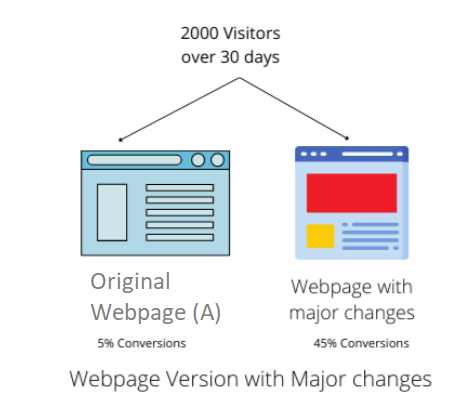
Website traffic is an essential resource for every online business. Yes, for the obvious reasons – because more traffic can convert to more customers and therefore more money in the till.
But traffic is also essential for data-driven optimization practices like conversion rate optimization (CRO).
Common CRO testing procedures rely heavily on website traffic for data to run conclusive tests.
Deriving insightful data from web traffic is no big deal for established enterprises like Amazon and Microsoft, which get millions of users every day.
But conversion optimization is more challenging for low-traffic websites.
That doesn’t mean these small businesses should give up on conversion optimization and resort to implementing random hypotheses.
The CRO tips and techniques below are proven to work for low-traffic websites.
The Difficulty In Optimizing Low-traffic Websites
We know how critical testing is to ensure that a website runs optimally and generates revenue.
Tests rely on data and to get a significant result, we need lots of data.
Improving a website’s rank to get more traffic can help in data acquisition.
But going this route can be quite expensive and time-consuming for new and small businesses.
You cannot wait for your website to rank organically and then implement CRO best practices.
However, performing CRO when your website barely gets any traffic is also challenging.
Such websites have smaller sample sizes, and it takes an inappropriately long amount of time to reach statistical significance when running tests with small samples.
Additionally, calling a test before it reaches statistical significance runs the risk of implementing a false positive and shooting yourself in the foot, potentially ruining any progress you may have made over time.
This is why A/B testing and optimization for low-traffic websites is challenging for most marketers.
CRO Tips For Low Traffic Websites
If you Google [Proven CRO Tips], you will come across plenty of generic CRO best practices that work well on high-traffic websites.
But what if you’re just getting started with a new website or struggling to build your audience for other reasons?
1. Run Tests With Low Confidence Level
The confidence level is a critical part of statistics that indicates how true your test results are for the entire population.
In simple terms, it tells you how reliable the test findings are and how safe you are from implementing false results.
The higher the confidence level, the higher the likelihood that a test result is true.
For example:
- A test between the samples A and B runs at 95% confidence.
- This tells us that sample A is better than B.
- That means we have a 95% chance of this result being accurate and sample A actually being better than B.
- And we have only a 5% chance of this result being false, where sample B being better than A.
When running tests on different samples, you are required to choose a confidence level that ultimately decides the sample size.
A 95% confidence level is the industry standard when performing CRO tests. This leaves only a meager 5% or one in 20 chance of the CRO tests results being false.
This is a risk everyone is happy to take.
However, being 95% confident in the accuracy of your test results requires a large sample size and when running tests on low-traffic websites, sample size is a scarce resource.
In this case, it almost makes sense to lower your confidence level to reduce the sample size needed to reach statistical significance.
Reducing confidence level also speeds up your test and helps you achieve results in a smaller time frame than running tests with the industry-standard confidence level.
Be aware though that when you lower your confidence level, you may compromise the accuracy of your test results.
It is up to you to decide whether you are willing to trade the accuracy of your tests with time.
In my opinion, you should not be afraid to test at 85% or even 80% confidence level.
It is better to test different variations in a shorter time frame rather than waiting for a large sample size to run a test with 90% or 95% confidence.
2. Track Micro-conversions
Conversion is a spectrum with lots of micro-conversions leading up to one macro conversion – the ultimate goal of your website.
Micro-conversions are incremental steps that represent a user’s interest in your brand.
Tracking micro-conversions could be a good idea when optimizing low-traffic websites because smaller conversions occur more frequently and hence are larger in number than the one macro conversion.
For example, an ecommerce website may have a higher add-to-cart rate than completed orders.
Or, a SaaS product may have higher free-trial signups than premium signups.
Tracking these smaller conversions will give you a higher baseline conversion to build your test around.
It is common knowledge that increasing baseline conversion decreases the sample size needed to reach statistical significance and run a successful test.
However, tracking micro-conversions, once again, trades accuracy for the possibility of conducting a successful test.
A micro-conversion may not necessarily contribute to your bottom line, and optimizing your website for these variables may generate misleading results.
Consequently, you can end up doing more damage than good.
So, how can you track micro-conversions while ensuring your efforts will prove profitable in terms of website conversions?
Focus on micro-conversions as a part of the whole user journey and optimize these variables to uplift the entire user experience of your website.
3. Go For Major Changes
When attempting to test a low-traffic website, you don’t have the liberty of testing minute elements and gaining granular insights into your users’ preferences.
And honestly, at this point, you can survive just fine without it.
But this doesn’t mean you can’t A/B test at all.
Going for drastic changes in your variation can lead to an increased lift in your primary variable.
In other words, if you implement a major change in your variation, you are more likely to see a more significant change in baseline conversion.
Let me explain.
If you test minor changes between samples A and B of your website, the difference in conversion would be extremely small.
Sample A may have 5% conversion, while sample B may represent 5.5% conversion.
With a lack of a large sample size, the 0.5% lift in conversion is not appreciable enough to conclude that sample B is better than sample A and implement it.
However, if you implement a massive change on your website, you may notice a bigger lift between control and variation.
Sample A (the control) may have the baseline conversion of 5%, while sample B with a considerable change may generate a 45% conversion.
This would show a 40% lift and indicate that sample B is better than A, and you can work your way up from there.
 Image created by author, January 2022
Image created by author, January 2022So, in short, if your test variation generates a higher lift in conversion, either positive or negative, it will be easier for you to declare a winner.
4. Use Personalization With Dynamic Data
Almost 66% of customers expect online engagement personalized according to their previous interactions and online behavior.
Website personalization is a critical CRO strategy that can lead to increased conversions, regardless of how much traffic your website gets.
Website personalization entails serving dynamic content to web visitors, as this content is more relevant to their preferences and better resonates with them.
Serving dynamic content is also a data-driven approach that does not rely on web traffic.
It builds on data retrieved from various sources such as a user’s:
- online behavior,
- search history,
- website interaction,
- location,
- demographic information,
- social interactions,
- CRM data,
- and more.
Netflix is a prime example of a business serving dynamic content.
It sends push notifications and emails with personalized content recommendations and adjusts the content on the Netflix home page based on your watch history.
Of course, personalization also needs testing and optimization. But tests, in this case, are not as reliant on website traffic as they otherwise are.
Linio, an ecommerce marketplace we’ll use for example, had more than 4 million products. They wanted to optimize their customer journey and better guide the customers to the right items.
For that, Linio employed a personalization engine and created highly personalized experiences.
Their website personalization efforts led to 30% increase in conversions and a 23% boost in revenue per user.
5. Deploy Usability Testing
User or usability testing involves testing a website to reveal its friction points and identify how well it serves its target audience.
It can help discover critical areas for improvements on your website, and enhance the overall user experience.
Usability testing is imperative for websites of all scales.
But it is particularly helpful for low-traffic websites as it only requires a handful of people to carry out tests and still yields meaningful results.
The sole purpose of enhancing UX is to increase conversions. Therefore, improving UX with usability testing should be a critical part of your CRO arsenal.
You cannot (and should not!) rule out usability testing just because it’s a qualitative approach.
Additionally, qualitative data is largely underutilized, so usability testing for optimizing conversions can give you an edge over your competitors.
You do have to be careful when choosing participants for your usability test.
It is ideal if your test participants align with your target buyer persona.
But if that’s not possible, it is important to ensure that these people know a bit about what you are doing to give context to your tests and contribute to meaningful results.
The Polish Great Orchestra of Christmas Charity, to use an example from Torsten Tromm, was struggling to gain donations from their web visitors.
They wanted to figure out the reason why online visitors weren’t making any donations and for that, they deployed usability testing.
The tests they performed led them to the realization that people found their website confusing and difficult to navigate through.
The visitors wanted to donate but didn’t know how.
Therefore, they redesigned their website to shift the donation button higher on the side menu and replaced the donation button copy from “Support it” to “Pay Online” to eliminate any confusion.
As a result of these adjustments, their donations increased by 420%.
6. Use Integrated Feedback Forms
The purpose of CRO is to optimize your website for an enhanced user experience.
And understanding your audience is important for good UX and hence should be considered in conversion optimization.
Brands spend millions of dollars trying to understand their audience so they can optimize their customer touchpoints to be more relevant for the users.
Deploying on-site feedback forms help you understand users’ behavior and won’t cost you millions, either.
Using these forms, you can get insights into how your target audience feels about your website and about their needs.
With closer inspection, you may uncover user behavior trends that can then guide your optimization process.
However, you have to make sure that you ask the right questions to ensure that the feedback you collect propels your optimization campaign in the right direction.
Additionally, you have to build and time your feedback forms appropriately so as not to frustrate the user.
Final Words
Conversion rate optimization is a data-driven process that, when done on websites, largely relies on data collected through website visitors.
But with low-traffic websites, this data is limited, which means you have a small sample size to work with, and quantitative tests may seem unreliable.
That’s no reason to give up on CRO entirely.
There are many quantitative and qualitative optimization tips and strategies you can implement to increase conversions, regardless of how much traffic your website gets.
These strategies include statistical approaches like lowering the confidence level or reducing variations.
Even if your traffic is too low for these tips, you can go for usability testing or feedback forms, which offer equally valuable insights.
More resources:
Featured Image: Griboedov/Shutterstock







